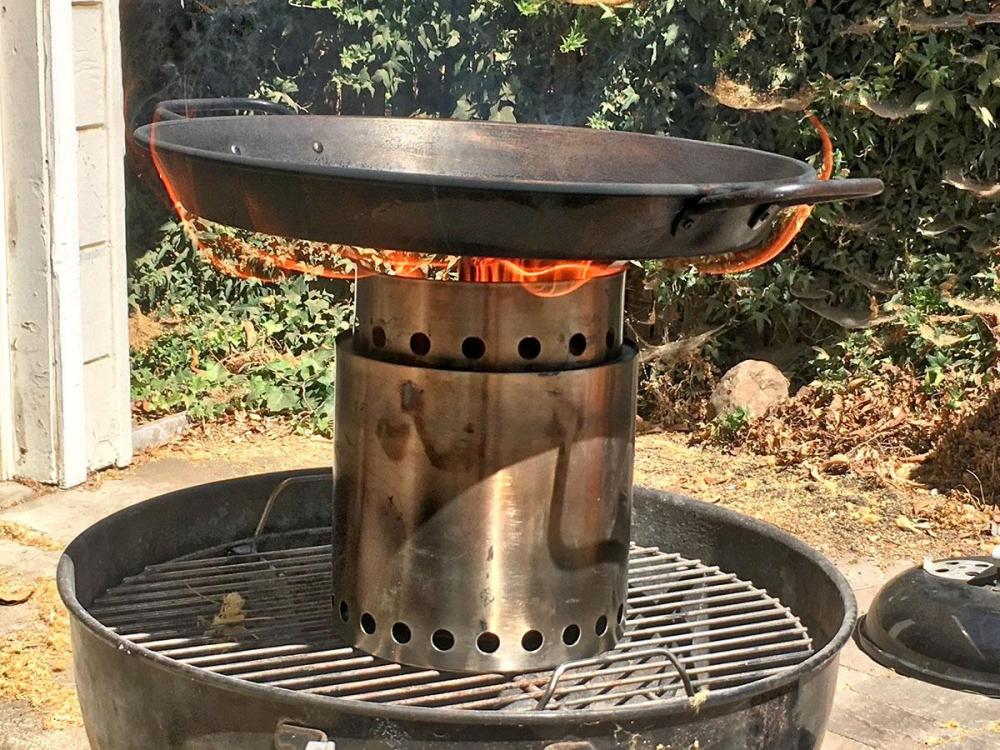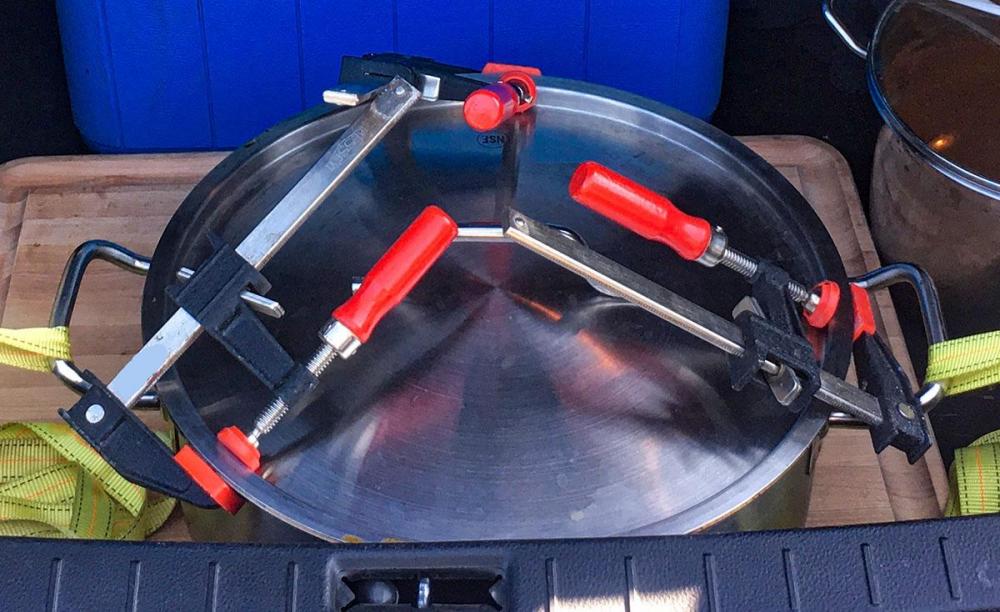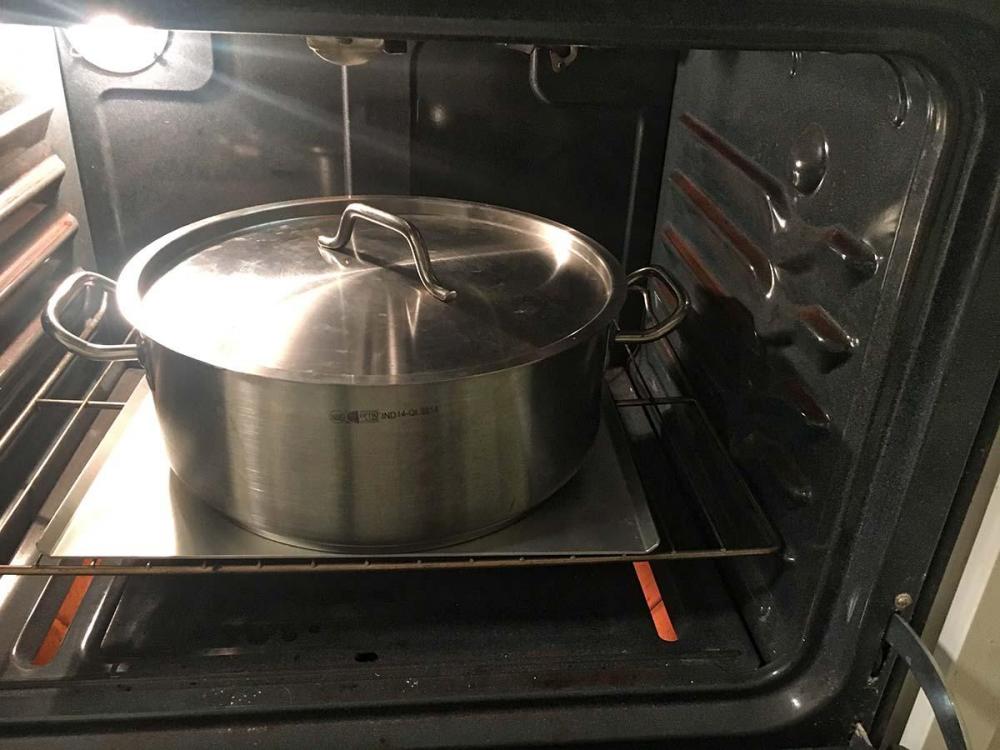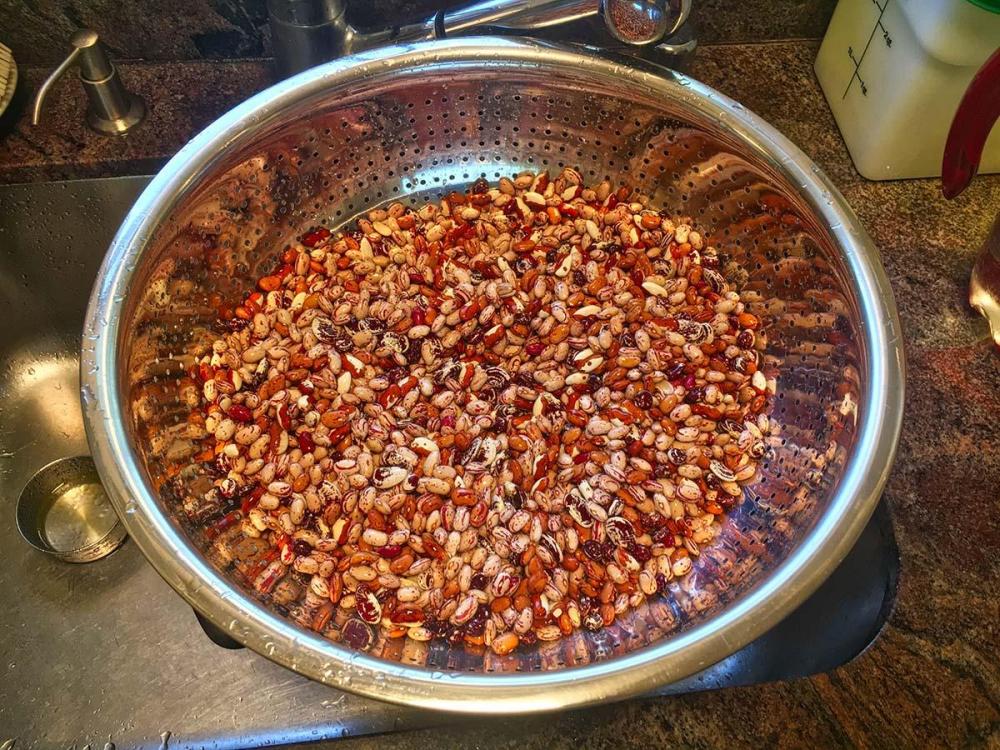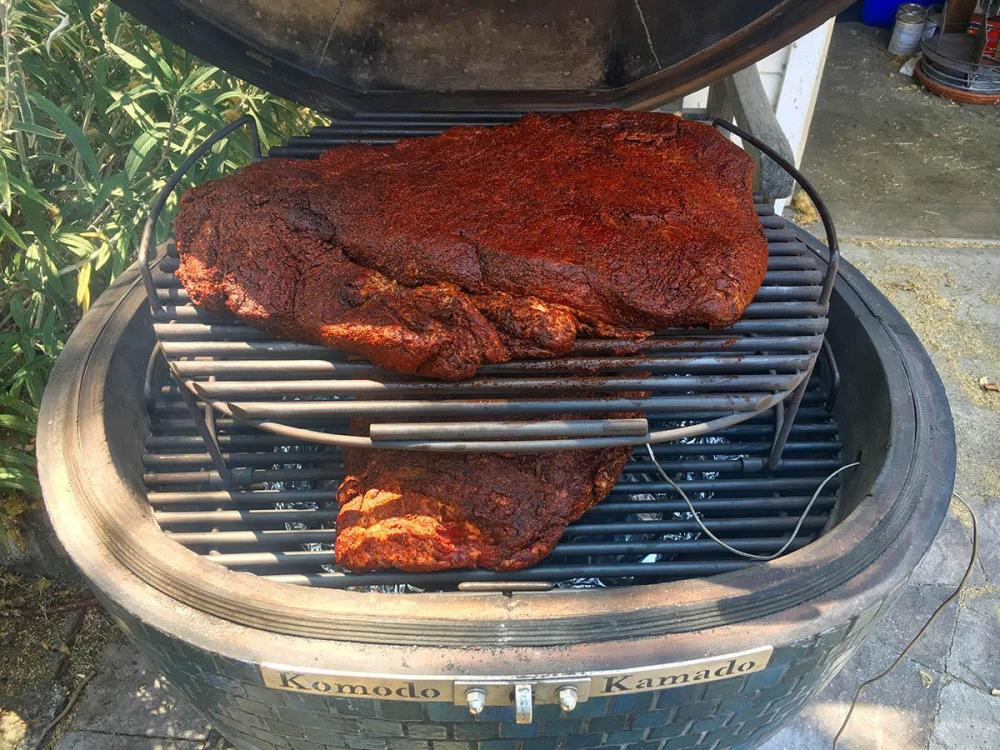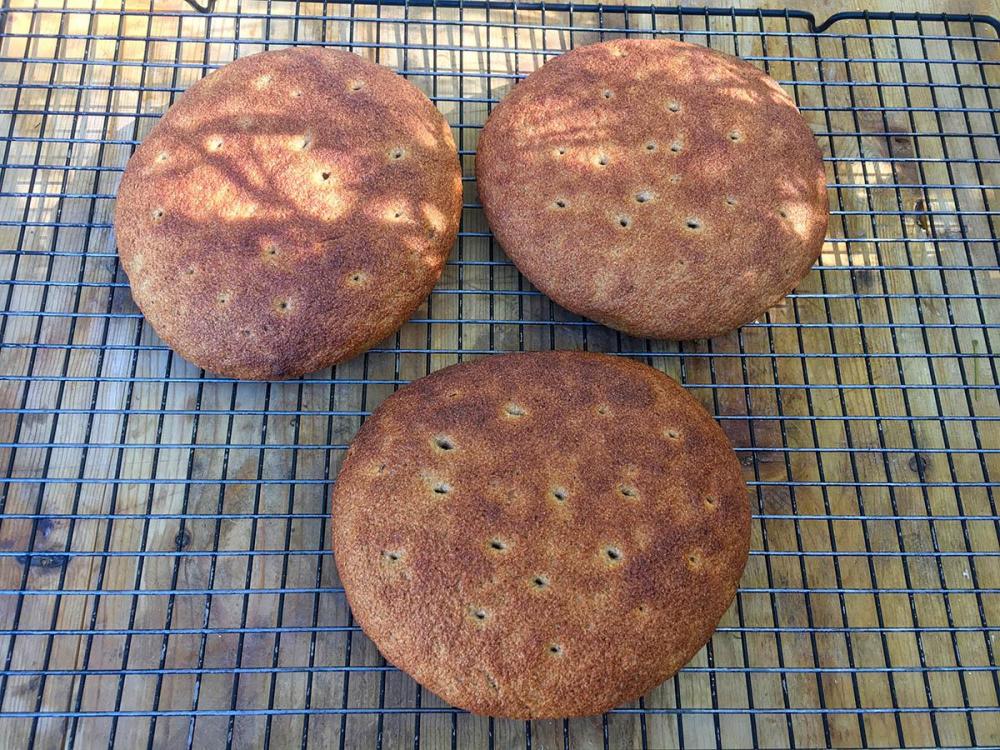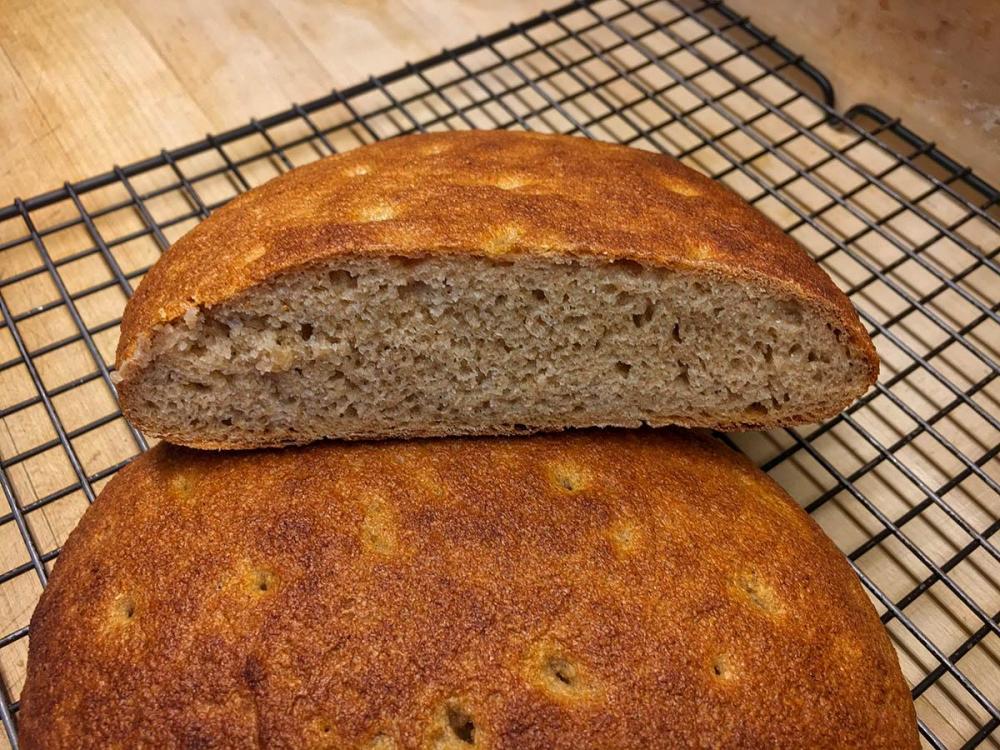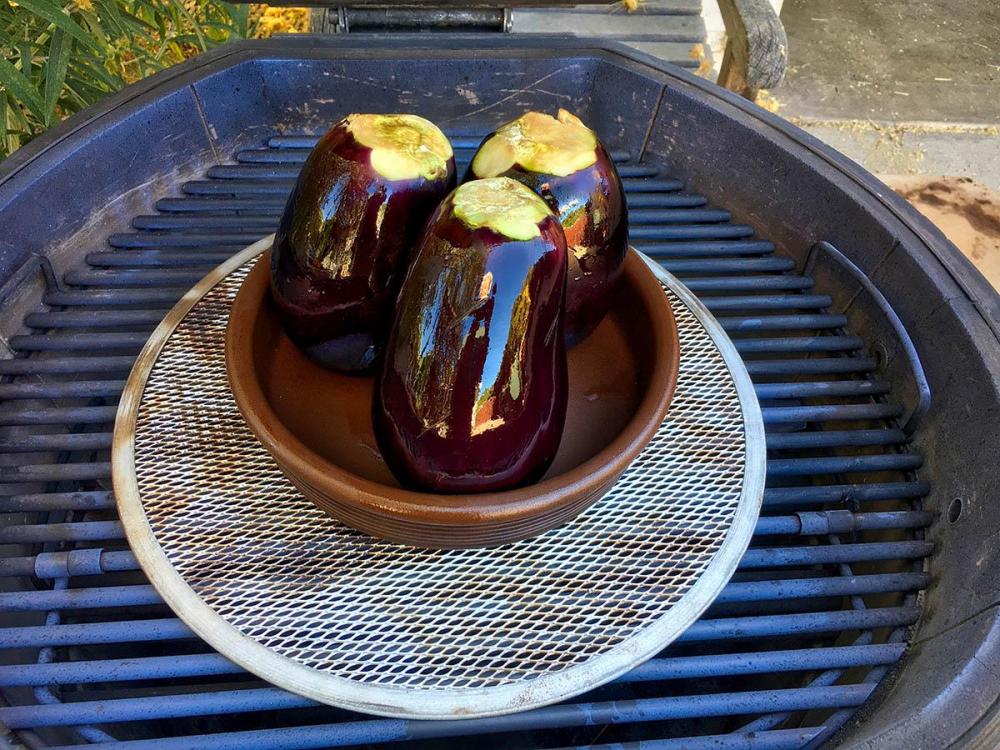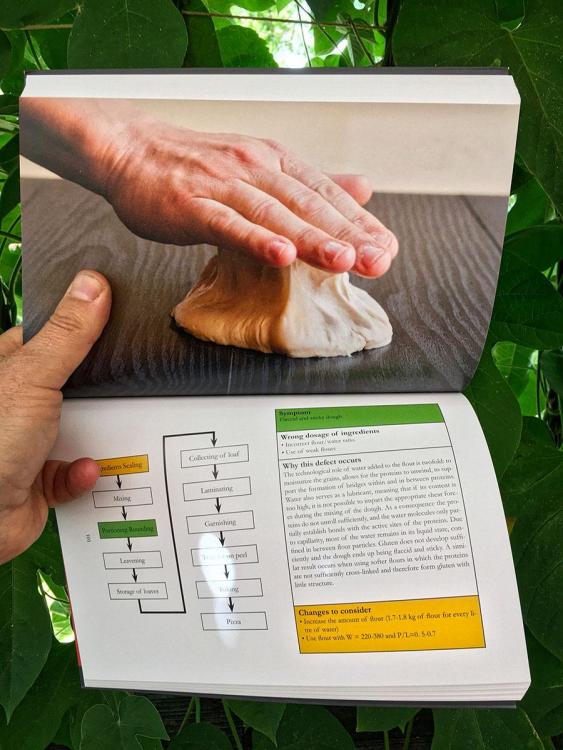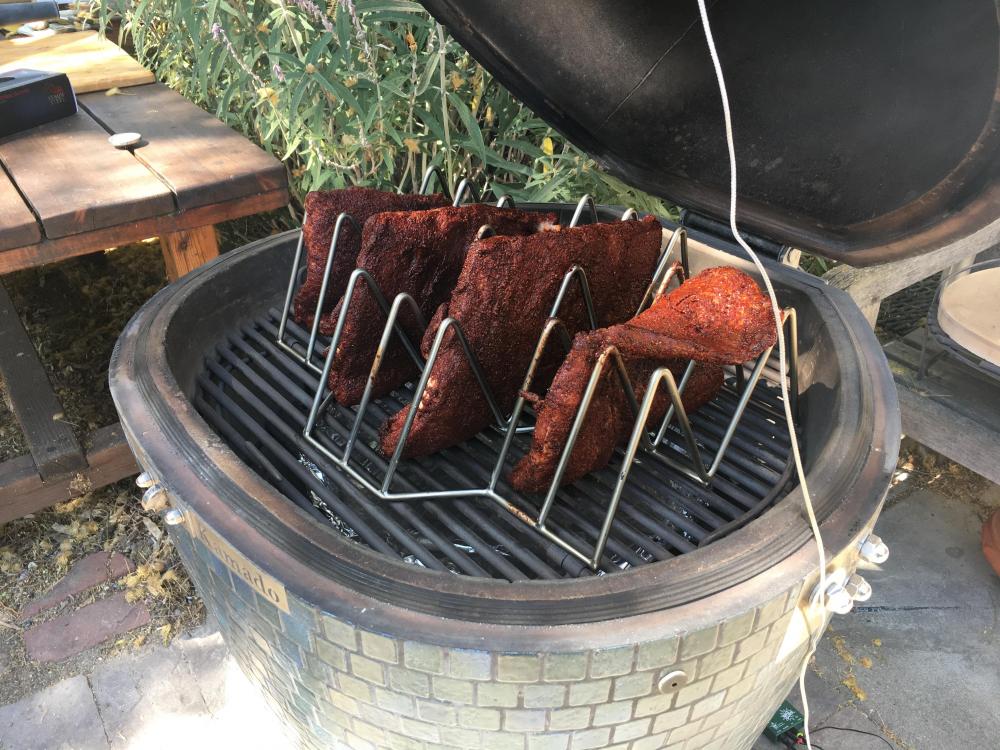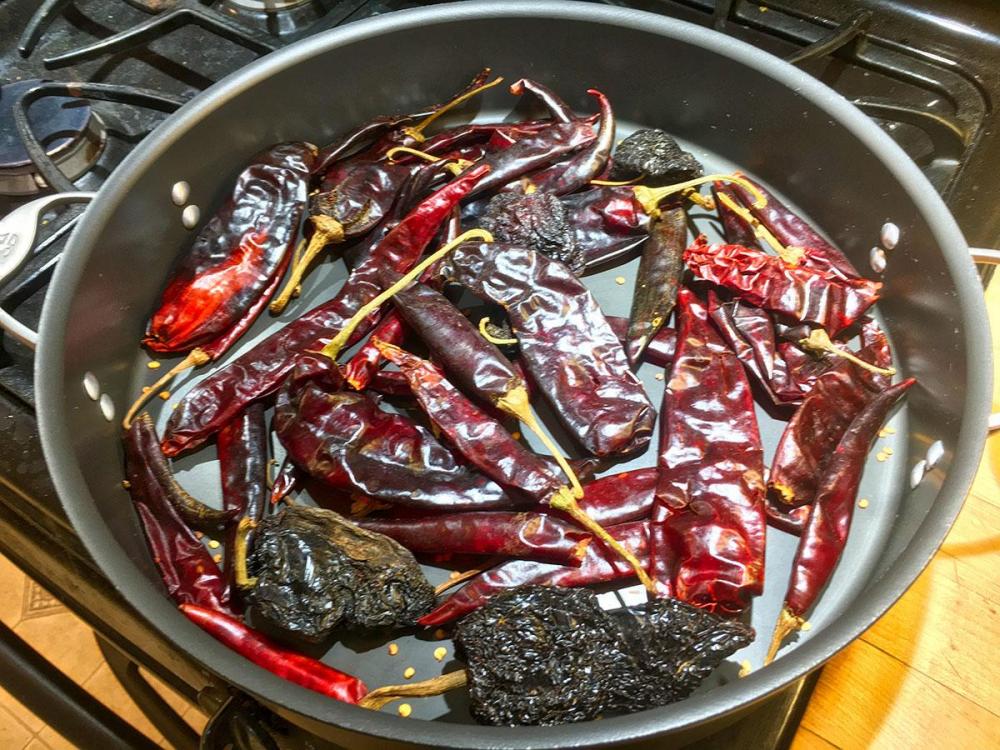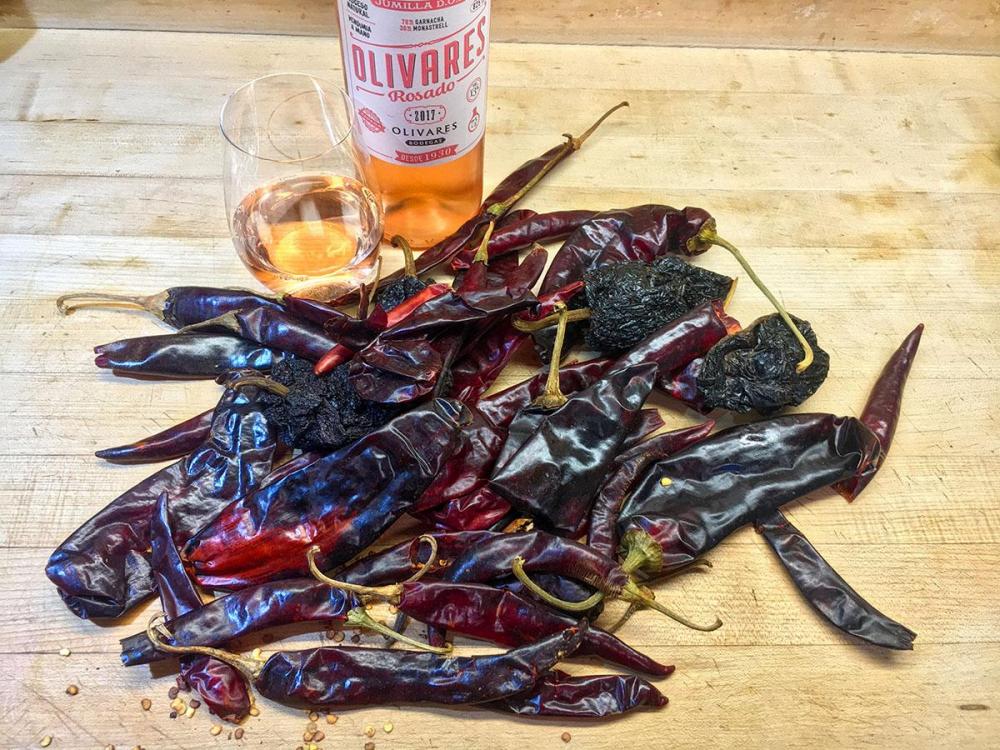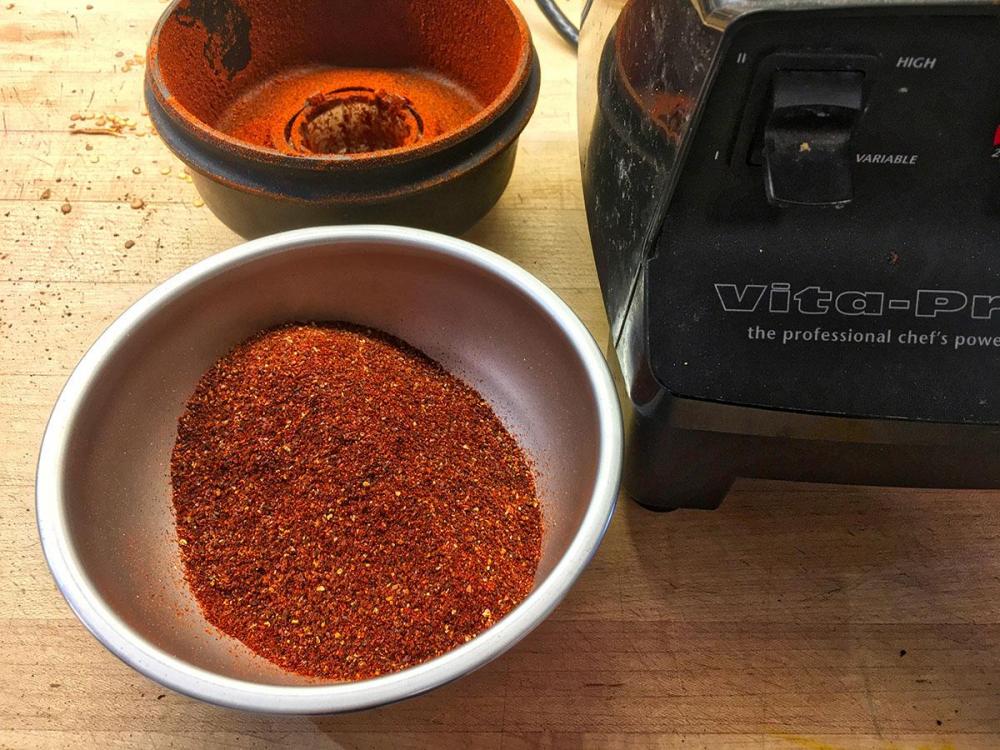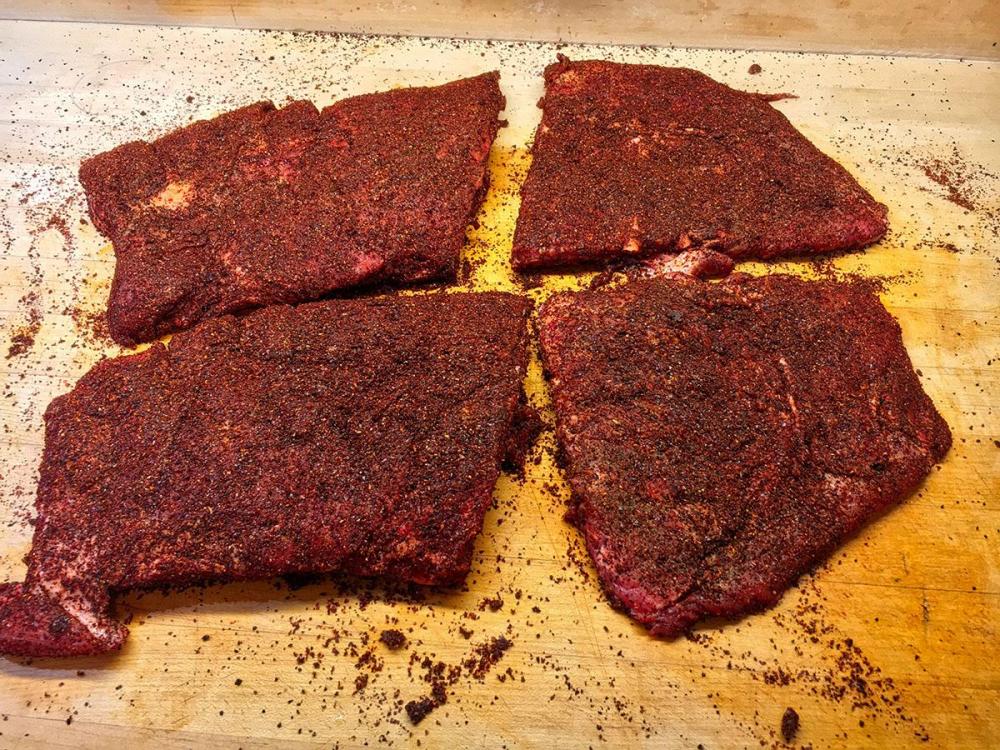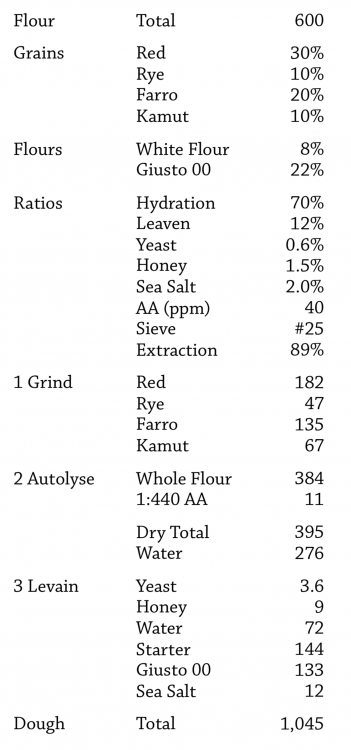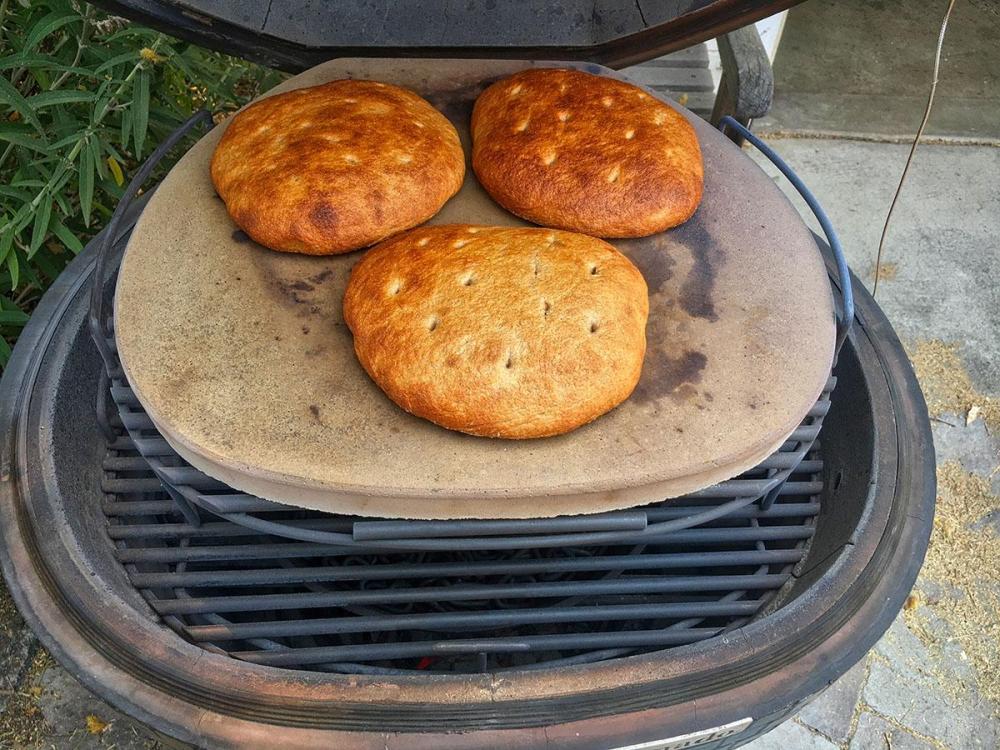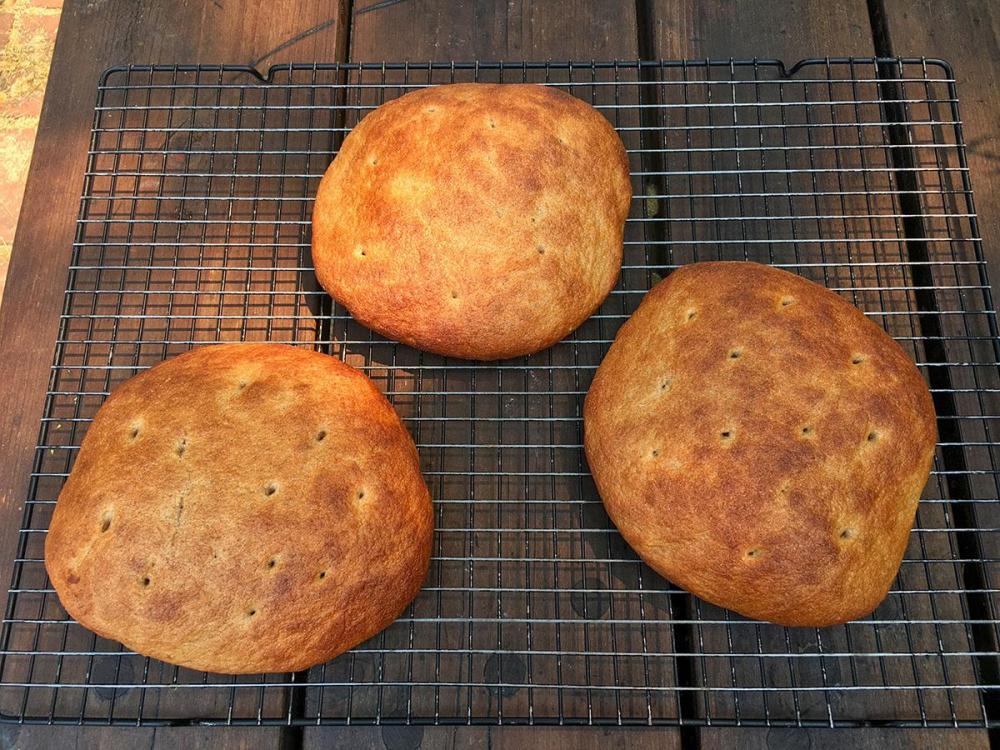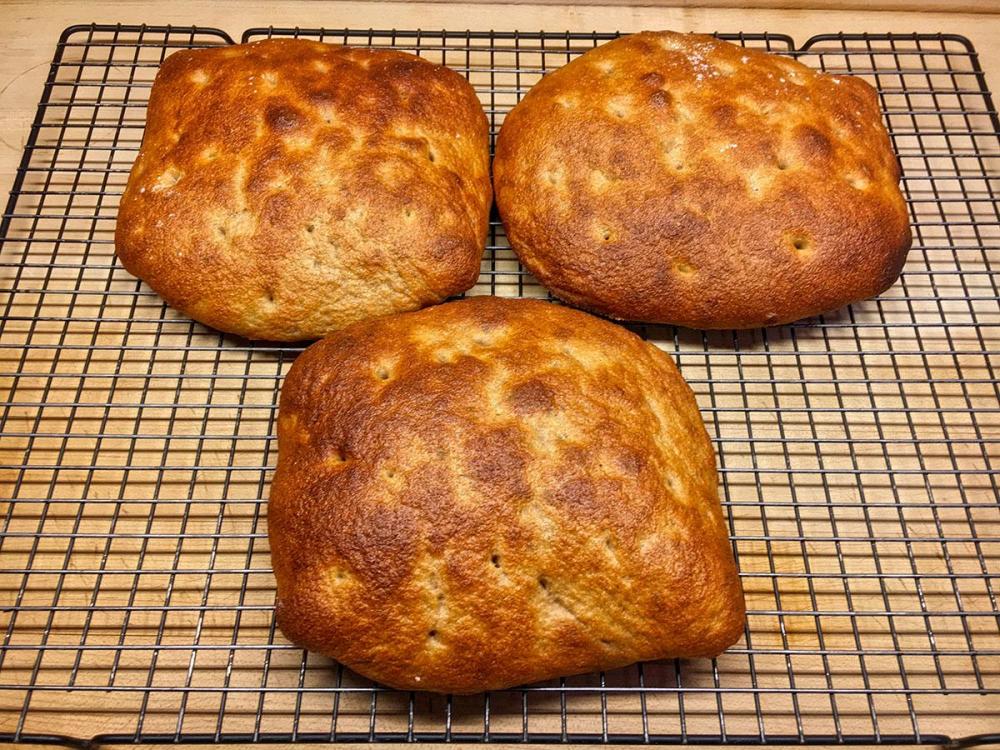-
Posts
1,739 -
Joined
-
Last visited
-
Days Won
53
Content Type
Profiles
Forums
Events
Everything posted by Syzygies
-
I lost all the tiles on Richard's K7 POSK. He still owes me one, though I wouldn't want it now. Hey, one way or another we're all children of rape. It worked out well; the workers Richard abandoned found Dennis.
-
How to get the beans to the brunch? Two briskets make a mess. An electric pressure washer isn't the fastest way to clean all grates, but it's effective and entertaining. What to do with the spent chips in a smoke pot? Reseason my drip pan?
-
The role of the fat cap finally dawned on me. It's absurd to think that basting with fat keeps meat moist. However, having a vapor barrier on one side will keep the brisket from drying out through that side. An intact fat cap provides that vapor barrier.
-
-
We're curious. We use various test sieves (such as Gilson 12in Round Test Sieve, All Stainless Steel - #35/500um) to sieve out some bran. "Grinds finer" is a simplification; one could establish a profile of particle sizes by sieving through a sequence of test sieves, and weighing. (This is actually what the test sieves are for, hence their name.) It's well understood how to compare two numbers, but how does one compare two profiles? That can be subjective. If the Mockmill produces a significant amount of flour that passes through a finer sieve than any flour from the Classic, then I'd accept the assertion that it grinds finer. It is possible that the Mockmill grinds to roughly the same minimum particle size as the Classic, but it grinds more of the flour to this fineness. If one wants the bran, great. If one wants to remove some of the bran, sieving it out depends on a particle size differential, in which case one might actively prefer the classic. The Classic grinds fine enough for my needs, unlike any other home grinder that I've experienced. Nevertheless, the flour doesn't feel like 00 pizza flour. There is room to grind finer. If I can figure this out, we might want both grinders.
-
Tonight's after-party is eggplant, roasted for Zaalouk. This bread is 80% home ground flour. That's pushing the limits even for the forgiving Moroccan form factor. However, we like the way it tastes, so I need to step up my game so I'm also happy at a technical level. It's funny, at my pottery studio as an unapologetic beginner, I'm keenly aware of how "showing masterful technique" trumps other reasonable design considerations, distorting this art form for the worse. Yet I'm vulnerable to the same error, making bread. We love how this tastes, even if it's a partial technical fail.
-

Moving onto breads... and way out of my comfort zone!
Syzygies replied to Chanly1983's topic in Techniques
There wouldn't be much point to preheating a stainless steel bowl. Steel only stores about 1/7th as much heat energy as water, for a given weight, and silver radiates heat more poorly than black. It would however contain moisture, while introducing very little lag in passing the oven temperature outside the bowl to inside the bowl. -

Moving onto breads... and way out of my comfort zone!
Syzygies replied to Chanly1983's topic in Techniques
With proper fuel choice and fire handling, any flavor/aroma components will be close to subliminal. The way the bread bakes can be markedly different. Some people build little brick caves in their ovens, or use two stones, under and just above their loaves. One can be cooking more with radiant heat in a KK, which is already a ceramic cave. To maximize this effect one would let a fire get a bit out of control, into low earth orbit. The KK will cool slower than the fire itself. Bake when the KK returns to an ideal temperature, on the tail end of the fire. This is impractical for bread, as the timing issues are too hard to manage. Dough is ready when it's ready. Pizza dough is designed to have a more generous "ready" window, but then one is still letting the fire decide "when's dinner", and the oven won't quite recover for second and third pies. So this is an ideal we can only approximate through more controlled shaping of the fire trajectory. I sometimes taste a hint of off aromas in the bread, that I ascribe to the lump charcoal. The faintest hint of chlorine? This consideration also favors a late-stage fire that has burned thoroughly (as does pretty much everything one does with fire, if one has the patience). -

Moving onto breads... and way out of my comfort zone!
Syzygies replied to Chanly1983's topic in Techniques
Two critical details: We remove the plastic bag before depositing the ice. Ice buys time to close the lid; one can get steam burns adding water. We use stainless steel chain. It costs more, but galvanized metals produce toxins when heated, and should be avoided in a barbecue pit. -

Moving onto breads... and way out of my comfort zone!
Syzygies replied to Chanly1983's topic in Techniques
These are important nuances. However, people have been baking bread for thousands of years; bread will come out no matter what you do. Just do it. One learns anything in the KK by starting simple, then adding refinements. Like @Pequod I like to use ample steam, but that's a modern refinement. People have been happy with their bread for decades, baked in a home oven, genuflecting with 10g of water from a plant spritzer. While I learned a great deal from the Tartine books, I find the actual bread from their bakery to have an overdeveloped, nearly burnt crust. My neighbor prefers my bread to Tartine's. She's not saying I'm a better cook; she's saying my bread is more comfortable. That's what matters: making bread that more nearly resembles what you crave than anything you can buy. Dutch ovens have an effect on the crust; do you want that effect? That kind of artisan crust may make you happy, or it may satisfy you that you are successfully reproducing a social convention. Liberate yourself from the latter impulse. Bread, like clay, should facilitate freedom from convention, not adherence. While Dutch ovens and ample steam both affect the crust; they are not interchangeable. Initial steam transfers a great deal of heat energy to the dough at once. I choose steam both for its effect on oven spring, and the freedom to vary the shape of my loaves. First, master fire control, baking on a Dennis stone (or similar, though his is best) in the KK. I recommend also using a heat deflector (the chain steam skillet we use serves as one, but anything will do), as a key issue here is "fire from below": One doesn't want the stone hotter than the KK walls. So an older fire that has stabilized, but isn't about to go out, is best. This is tricky. As I get busy, I've taken to using a BBQGuru with their biggest fan, and a pit probe poking through the dome thermometer hole (not the side probe port), to stabilize a long fire at 450 F. Even then, there's an art to not overshooting. However you manage your fire, learn to do so for bread before adding other complications. I have KK Moroccan bread working again this morning. Before going to Morocco, I didn't really get Moroccan bread. It's a flat bread, an inch or more high, that's very forgiving and very versatile. Their protocol is dead simple, though I've restored most of what I do for my sourdough bread. -
Huh. Very curious about the brisket. I've been in the long slow cook school for brisket, but I'm very picky as to which briskets to cook this way. I look for true marbling of fat and other solubles. I've always imagined that the leaner brisket benefits more from the quicker, hotter cooks. The Golden Gate Meat Company sells fantastic briskets from the Ferry Building in San Francisco, and by prearrangement they'll dry age for me. I've tried eight days and four days. Everyone loved eight days but I thought it came out too soft, almost eat-with-a-spoon. Four days was better, but I've been skipping the dry aging since. The jury is still out for me, here. It may be funky cow is the ideal source for some cuts but not brisket. I remember when beef cheeks were all the rage in NYC bistros. My attempt here was dismal. Laurie blamed the too-hip-for-words sourcing, said the cow had smiled too much.
-

Common Mistakes in a True Neopolitan Pizza
Syzygies replied to ckreef's topic in Bread, Pizza, Pastries or Desserts
Jan L. A. van de Snepscheut -

Common Mistakes in a True Neopolitan Pizza
Syzygies replied to ckreef's topic in Bread, Pizza, Pastries or Desserts
The factor he's taking into account is the WAF. (Apparently the Mayan EVFO pizza is a myth.) -

Common Mistakes in a True Neopolitan Pizza
Syzygies replied to ckreef's topic in Bread, Pizza, Pastries or Desserts
True, but we have access to authentic Neapolitan dough recipes, and many of us have worked out our dough recipes from scratch. I sometimes bake pizza at 600 F, when I'm confident that the stone itself isn't much hotter, and I still watch very carefully. Whatever the recipe, it gets much harder to bake successfully above that temperature. One can mitigate the "fire from below" issues, but not completely. My neighbor has four different rigs, counting his wood-fired pizza oven. The Komodo Kamado is a Swiss Army knife. It does a great job with pizza but it is definitely not specialized to the task. -

Common Mistakes in a True Neopolitan Pizza
Syzygies replied to ckreef's topic in Bread, Pizza, Pastries or Desserts
Rosetta Costantino meant get a home oven as hot as it goes (without hacking the self-cleaning mode to get the door to open!). That's below reputed Neapolitan temperatures. She's an engineer by training, with a successful Silicon Valley career that gave her the chance to retire young. So I believe her when she told us she brought an infrared temperature shooter around Italy, and never saw temperatures as high as claimed, where the pizza actually landed in the ovens. Huh. At the same time, The Neapolitan Pizza book is clear that the oven floor must be brought to 380 C - 465 C (715 F - 870 F). What follows are heat transfer equations. Huh. I'm reminded of firing cones, for pottery kilns. While one can describe what happens in a kiln by final temperature, a "cone" is a canary in the mineshaft to witness and integrate the entire progress of the cook. We talk about temperatures as a result of modern-day indoctrination, as if the model replaces reality. Mathematicians are the worst offenders; their tendency to substitute idealized models for reality turns what should be fairly smart people into blithering idiots. (I try to avoid discussing politics with mathematicians; the world doesn't always work the way they think it does.) So 550 F is just a guideline; there are many ways to come up with this reading. The Tel-Tru thermometer reading the air temperature just inside that dome hole is simply there as a chance to say "oops, that fire got away". Infrared readings of the stone and the inside dome are more relevant. As others say, an older fire that burned too hot but is now calming down is easier to work with (like so many of us). We use a substantial proportion of home-ground whole wheat flour in our dough, and we're simply making food we want to eat, not reproducing an authentic standard. What I know is that when our KK gets too hot, the crust burns before the dough or toppings bake as we'd like. Perhaps the best description of a pizza, besides thickness and topping weight, would be cooking time. One can guess oven conditions from cooking time. A Neapolitan pizza bakes 60 to 90 seconds, according to the standards reported in The Neapolitan Pizza book. Our pizza bakes 6 to 7 minutes. -

Common Mistakes in a True Neopolitan Pizza
Syzygies replied to ckreef's topic in Bread, Pizza, Pastries or Desserts
I experimented with many add-ins, including diastatic malt powder, figuring out sourdough bread in the KK. I stopped using it after a few tries. I want to bake my bread as long as feasible. A browning agent shortens this window with no compensating benefit that I could identify. We took a pizza class with Rosetta Costantino (author of My Calabria). She favors the hottest oven one can arrange, so she counsels stripping any dough recipe of any add-ins (sugar, oil) that increase browning. Like landing a plane in adverse conditions, one wants the longest possible runway. My neighbors installed a dedicated wood-fired pizza oven, which presents its own host of challenges. By comparison, the main challenge (in my experience) using a KK is properly contending with the "from below" heat source. Without a heat deflector, essentially all of the heat is coming up through the stone, and one ends up pan-roasting the pizza. Recall the often-given advice for wood burning pizza ovens: Measure the stone, not the air. There's considerable lag in the stone. In the worst case, a fire got away but one corrects, thinking the new lower air temperature means one can bake pizzas after all. The still-too-hot stone then incinerates the pizza crust before the topping cooks. My favorite way to bake/roast anything in the KK is to start the fire earlier than one thinks necessary, and cook after the fire is dying down, but the KK itself is very heat soaked. This is tricky to both time and manage, but then one is cooking more with radiant heat from the KK walls, for a more even effect like a dedicated wood-fired pizza oven. -

Common Mistakes in a True Neopolitan Pizza
Syzygies replied to ckreef's topic in Bread, Pizza, Pastries or Desserts
Ok, the book came. Beautiful production values; the paper is so sturdy that I was sure I was skipping pages. Until page 100, dry and technical to a degree one wouldn't expect in a parody. How to fulfill the EU standards for making Neopolitan pizza. Some interesting details on proportions, mixing, rising. Pages 100 to 153 is an entirely different book. Each pair of pages is a stunning photograph, and a detailed description of a way pizza can go off the rails, and what to do about it. Worth the price of admission. -
Sieve, regrind what doesn't pass through the sieve. My usual technique also for spices. For example, freshly ground turmeric can be sourced from multiple varieties of turmeric (Kalustyan's has whole Alleppy turmeric from Kerela, in addition to the usual turmeric, and Aleppo, Maras, and Urfa peppers), and tastes much better than preground (even grinding a month at a time, for multiple Indian and Moroccan meals). I bash whole turmeric into smallish pieces in a mortar, grind, sieve, grind, ... No picture, but I put my two quart Dutch oven smoke pot on top of my Solo Stove Campfire (still on sale a few more hours), to preheat it and get some initial lump charcoal embers to go underneath in a cradle of coco extruded lump. I was going to take a picture, but I saw the smoke pot off-gassing a small, beautiful flame, so I knew it was ready. For anyone who thinks I was already crazy to use flour paste to seal my smoke pot lid, I'm sorry to introduce the complication of preheating the Dutch oven. It however worked amazingly well. I'm willing to do whatever it takes to make the best food I can; the flour paste is a chance to meditate on the childhood reasons why I once feared complexity in cooking. And a chance to wonder why I never tried a stainless steel Klean Kanteen instead. They make an optional stainless cap; one would need to remove the silicon seal. I'd drill 1/8" holes as usual, along the side that faces down to burn off-gassing, and three or more in case one is unfortunately blocked by shifting wood. One doesn't want to create a bomb; the Dutch oven has the advantage that in the worst case it will simply blow it's lid. Huh. Meditation over, maybe I'll stick to Dutch ovens. They do hold more.
-
Last night's spareribs prep. By request for a 4th of July party. We have many Mexican markets nearby in California, making it easy to find great chiles.
-
I believe the color is from two sources: I hydrolyze the whole grain flours overnight, developing natural sugars. And I proof the yeast with a bit of honey. Baking at 435 F in a KK, these both contribute color if one is patient. Overall, this is a simplification of my sourdough batards, that you have made. Overnight hydrolyze, then knead in remaining ingredients using a stand mixer. Two to three hour bulk rise, ten minute bench rest, 90 minute proof in final loaf shape. I've played with many variations of the above. Wetter doughs are harder to work with, and transfer to the oven. The farro adds great flavor and texture. It's a mistake to add the starter the night before, or to knead too far in the stand mixer. And so forth. The form factor is very forgiving; one can go all whole grains, and leave out the AA. (The recipe assumes a 100% hydration starter, 2:1:1 white flour, red wheat, rye. The water handling is tuned so the hydrations of the two components match, for ease of mixing.)
-
Yes, Aleppo and Marash are quite similar. We have both, and sniff each of them to decide what to use. Use it like and along with black pepper; do as the Romans and start the black pepper, red pepper in your oil before adding anything else. While the potato onion dish is a great side by itself, we generally use it as an upgrade to replace frying the potatoes and onions for Tortilla Española (Spanish Egg and Potato Omelette).
-
I'm starting to get the hang of Moroccan bread. Some transfer from that pizza thread helped. Never start a fire without a plan for the after-party. Here, an idea I saw in a Spanish cookbook once: Toss potato slices and onion slices in black pepper, pimenton, Marash pepper, cumin, salt, and olive oil. Bake for an hour or two in a clay cazuela.
-

Common Mistakes in a True Neopolitan Pizza
Syzygies replied to ckreef's topic in Bread, Pizza, Pastries or Desserts
The physics of baking good pizza Yeah, that helps. -

Common Mistakes in a True Neopolitan Pizza
Syzygies replied to ckreef's topic in Bread, Pizza, Pastries or Desserts
So I tried Enzo Coccia's Pizza integrale dough (20% freshly ground Giusto's Organic Wheat Berries (Hard Red), 80% Giusto's Organic “00” Unbleached Flour). Nice recipe; next time we'll double the whole wheat. Carefully following his kneading instructions, I obtained a dough that was better than I'd ever realized before at not forming thin spots or holes. (I'm sure others have long been here, but this was a welcome surprise for me.) My attempts at imitating his slapping technique for forming the pizzas was laughable. Yet, somehow, it worked. -
Still working on my Moroccan bread recipe. A bit wet, so it doesn't hold its shape, transferring to the KK. Red wheat, farro, rye, kamut, semolina, sourdough starter.



